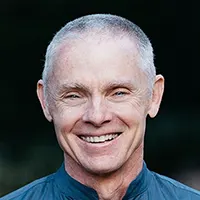Awakening, in one way of speaking of it—and it’s just conceptualizing it, which is never going to be completely accurate—but it’s when the awareness that’s operating right now in everything you see, what you feel, what you hear—all of that, without awareness, none of that is possible, or certainly knowable. And we can have that operating our whole life and think it’s just something we’re doing, which is weird because it happens without you doing anything. But all of the sudden, at some moment, it becomes—“it” meaning your awareness—becomes conscious of itself. It’s as if awareness goes, “Oh! I recognize myself!” It’s very similar, actually, to when a child—at whatever age; two years, three years; it usually happens gradually, not as a moment. But if it happened as a moment it would kind of go something like some kid staring in the mirror in a totally merged state, and all of a sudden they go, “Holy smokes, that’s me in the mirror!” If it happened all at once, you imagine what a radical sea change of experience that would be if that’s what happened with children? It tends to happen more gradually, but if you could condense that all into one moment, it would be shocking! In a great sense, because it would feel like a new and amazing discovery. Before, you’re just in this cosmic blob of experience, and then the next minute, boom! There you are: recognizing yourself in a mirror. You can just imagine the feeling of amazing discovery, as if: how did that suddenly happen? It tends to kind of gradually happen. It actually keeps gradually happening in many ways up through our mid-twenties, in a way.
But in essence that’s the transcendent aspect of being, when awareness becomes conscious of itself: “Oh! I am!” Like when Ramana Maharshi had a terrible shock of a relative dying. And, as it happens when we’re paying attention, it brings out some deep questions. And in his 16-year-old mind he thought, “Hmm, I wonder what that’s like.” And unlike most of us adults—probably most human beings—instead of worrying about it, and thinking about it, and rushing to the Internet and getting ideas of what happens when you die, and collecting theories, he just simply laid down and sort of gave it a good shot. He kind of pretended, in other words. Literally. Like, he’d sit, “Now, if I laid here, what would happen if I died? Well, this would happen, and this would stop happening, and this would stop happening,” and he just sort of went through… it was an imaginary experience, but it was very meditative. It was a high act of spiritual contemplation without him even knowing what he was doing. And all of a sudden, “Ah!” That great awareness became conscious of itself. And at that moment his sense was like: “Oh, this is what I really am. If death happens, this is what’s left.” At least that’s what he felt.
Which is, I think, itself a great teaching, not only in the mechanics of that, but actually just even before the mechanics was that he had an experience, a universal human experience—you know, like I say: none of us are getting out of here alive; not in a relative sense—and instead of looking for a bunch of theories about it (there’s nothing wrong with that), but instead of doing that, a bunch of ideas, the first impulse he had was to immediately just confront that experience, confront that fear. Like, let me go into that rather than away from that. And let me imagine what that would be like. That itself is a really good teaching. Just that. By god, if we could actually move towards what we became afraid of, you know? Just become curious about it, and at least begin with doing it experientially rather than theoretically.
Well, this is the whole of contemplative practice, isn’t it? It’s actually going into your direct and immediate experience of being. We did it for fifteen minutes before I opened my mouth and filled the room with sound. There’s a reason that I start all these meetings with fifteen minutes of silence, because it’s my way of trying to communicate—usually without saying it like I’m going to do now—but it’s my way of trying to have us all embody something, which is that that direct encounter with your immediate experience of being is the most important thing there is, spiritually. Everything else is… without that, there’s no foundation. It’s a bunch of ideas without foundation. It’s like whipped cream with no cake underneath, right? So it’s an attempt whenever we come together of saying, “Don’t forget what’s important. Don’t be mesmerized by the words.” And most days I don’t speak in a way that’s probably particularly mesmerizing, but maybe every now and then. But don’t be mesmerized by it all. Because all the talk is actually a way of giving form to what can happen in that silent encounter with our immediate experience of being, and that’s essentially what Ramana was doing.
The Buddha did something similar. It doesn’t look similar, but he had this encounter with this shocking reality of life and thought, “I’m going to go into the forest and meet this, and encounter this, and see what the best possible response to this universal human experience is,” right? I can try to run from it the rest of my life, I can try to deny it, I can try to whatever—but I’m going to try to see if there’s a resolution to this. Hence the deep dive into his experience of being. So I think when all of us come and meet in a way like this, it’s that I hope something like that forms the foundation; this immediate encounter with the direct experience of being.
